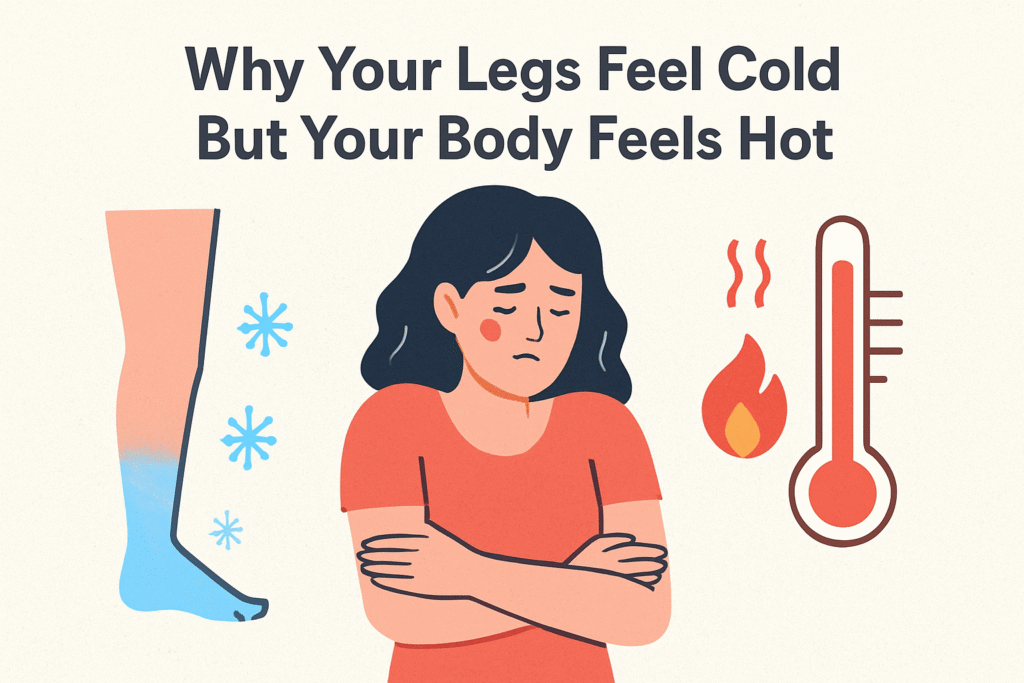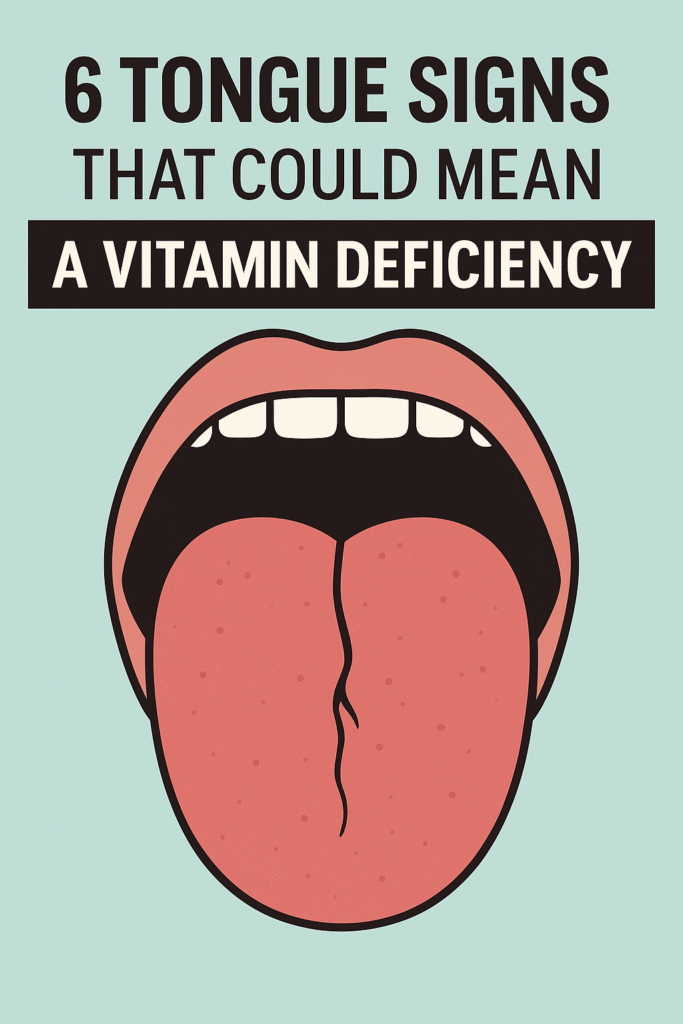
⚠️ Affiliate Disclaimer: This post may contain affiliate links, which means I may earn a small commission — at no extra cost to you — if you make a purchase through one of these links. I only recommend products or services I genuinely trust and believe can provide value. Thank you for supporting My Medical Muse!
Why Your Legs Feel Cold but Your Body Feels Hot: 9 Hidden Reasons and What to Do
It’s a confusing sensation, your body feels warm or even flushed, yet your legs feel cold, sometimes icy cold to the touch. You might pull on socks or blankets for your legs while feeling like you could shed layers above the waist.
This uneven temperature feeling can make you wonder, is my circulation off? Is something wrong with my nerves or hormones?
You’re not imagining it, the body’s temperature regulation system is incredibly complex, and when it goes slightly off-balance, some parts can feel cooler or warmer than others.
Let’s unpack why your legs might feel cold while your body feels hot, what it can signal, and how to bring things back into balance.
1. Uneven Blood Circulation
The most common reason your legs might feel cold while your upper body feels warm is uneven or reduced blood circulation.
Your circulatory system is like a highway network for heat, blood absorbs warmth from your body’s core, where most heat is generated and delivers it to your limbs.
When this flow slows down or becomes restricted, less warmth reaches your legs and feet, leaving them cold even as your upper body remains comfortably warm or even overheated.
How It Happens
When blood vessels narrow (a condition known as vasoconstriction) or when blood flow slows, the extremities like your legs and feet are the first to lose warmth. This can happen due to:
- Long hours of sitting or standing still
- Low blood pressure
- Tight clothing restricting circulation
- Dehydration (which thickens the blood slightly)
Your body naturally prioritizes vital organs in the chest and abdomen when circulation weakens, so it reroutes blood flow away from your limbs. The result? Cold legs despite a warm core.
Common Causes of Poor Leg Circulation
- Sitting or standing in one position for too long
- Peripheral Artery Disease (PAD): where arteries in the legs narrow, reducing blood flow
- Smoking: nicotine constricts blood vessels and reduces oxygen delivery
- Diabetes: damages blood vessels and nerves over time
- High cholesterol or hypertension: can clog or stiffen arteries
- Sedentary lifestyle: reduces overall vascular efficiency
You may also notice other signs of circulation issues like:
- Legs that feel heavy or numb
- Pale or bluish skin on the feet
- Swelling around ankles
- Cramping, especially when walking or climbing stairs
Improving circulation doesn’t always require drastic changes. Consistent, gentle actions go a long way:
- Move every 30 minutes: Set reminders to stand, stretch, or take short walks if you sit a lot.
- Elevate your legs: Prop them on a pillow or ottoman for 10-15 minutes daily to promote venous return.
- Stay hydrated: Dehydration thickens the blood, making circulation less efficient.
- Avoid tight clothing: Especially around thighs, knees, or calves, which can constrict blood flow.
- Exercise regularly: Walking, swimming, and leg stretches stimulate healthy vascular function.
- Eat circulation-friendly foods: Citrus fruits, leafy greens, garlic, and omega-3 fatty acids support vessel health.
See a doctor if, your legs often feel numb, cold, or painful, or if you notice changes in skin color or temperature. These could signal Peripheral Artery Disease or other vascular issues that need medical evaluation.
2. Nerve Dysfunction (Peripheral Neuropathy)
If your legs feel cold but aren’t actually cold to the touch, the problem may not be in your circulation, it might lie in your nerves.
This condition, called Peripheral Neuropathy, affects the nerves that transmit sensory information (like temperature and pain) between your brain, spinal cord, and limbs. When these nerves are damaged or malfunctioning, they can send the wrong signals, making your legs feel cold even though their temperature is normal.
What’s Happening Inside
Healthy sensory nerves detect external temperatures accurately and send real-time updates to your brain, but when nerve endings become irritated, compressed, or damaged, the messages get scrambled.
Your brain might interpret mixed signals like:
- “Cold” when the temperature is normal
- “Burning” when there’s no heat
- “Tingling” when there’s no movement
This mismatch between real temperature and perceived temperature creates the frustrating sensation of cold legs despite warm skin.
Common Triggers and Causes
- Diabetes: High blood sugar levels are the leading cause of peripheral neuropathy, gradually damaging tiny nerve fibers in the feet and legs.
- Vitamin Deficiencies: Especially B vitamins (B1, B6, B12) which are crucial for nerve health.
- Chronic Alcohol Use: Alcohol depletes B vitamins and directly harms nerve tissue.
- Thyroid Disorders: Low thyroid levels can slow metabolism and affect nerve conduction.
- Certain Medications: Chemotherapy drugs, some antibiotics, and blood pressure medications can affect nerve sensitivity.
- Nerve Compression: Issues like sciatica, herniated discs, or prolonged sitting can pinch nerves that serve your legs.
Associated Symptoms
Alongside the feeling of coldness, you might notice:
- Tingling or a “pins-and-needles” sensation
- Burning or shooting pain
- Numbness, especially in toes or soles
- Muscle weakness or unsteadiness when walking
These sensations might come and go or progressively worsen if the underlying cause isn’t treated.
What to Do
Addressing nerve dysfunction requires a mix of nutritional support, lifestyle changes, and medical evaluation.
Here’s how to start:
- Get a blood sugar and vitamin test: Diabetes or B12 deficiency are frequent culprits.
- Improve your diet: Eat foods rich in B vitamins, omega-3 fatty acids, and antioxidants (fish, eggs, whole grains, leafy greens).
- Avoid alcohol: It interferes with nerve healing.
- Stay physically active: Light activities like walking or swimming increase blood flow to nerves and help them recover.
- Try gentle warmth: Warm foot baths or mild massage can stimulate circulation and soothe discomfort (but avoid very hot water if you have numbness).
- Check your posture: Avoid sitting for too long; change positions often to prevent nerve compression.
- Consult a neurologist: Especially if symptoms persist, worsen, or begin to affect your balance or sleep.
Never ignore tingling, burning, or sudden weakness in your legs, early diagnosis of nerve issues often prevents permanent damage.
3. Autonomic Nervous System Imbalance
Your autonomic nervous system (ANS) regulates the body’s automatic functions, heart rate, blood pressure, sweating, and temperature control. When this system becomes imbalanced, it can send conflicting temperature signals throughout your body.
How It Happens
The ANS has two main branches:
- The sympathetic nervous system (“fight or flight”) which raises body temperature and heart rate.
- The parasympathetic nervous system (“rest and digest”) which cools and calms the body.
If your sympathetic system is overactive for example, during chronic stress or anxiety, blood vessels in your upper body may dilate (causing warmth or flushing), while those in your legs constrict, reducing blood flow and creating that cold-leg sensation.
This imbalance can make your upper body feel hot and your legs cold, even when the room temperature is normal.
Common Causes
- Chronic stress or anxiety: triggers ongoing “fight or flight” activity.
- Overactive thyroid (hyperthyroidism): overstimulates the nervous system.
- Certain medications: especially beta-blockers, antidepressants, or stimulants.
- Dehydration: lowers blood volume and stresses the nervous system.
- Postural Orthostatic Tachycardia Syndrome (POTS): affects circulation and temperature regulation when changing posture.
What to Do
- Practice deep breathing: Slow, rhythmic breathing activates the parasympathetic system.
- Ground your body daily: Gentle stretching, walking barefoot, or mindfulness helps regulate nervous tone.
- Stay hydrated: Include electrolytes to maintain nerve conductivity and blood flow.
- Balance thyroid health: Get thyroid hormone levels tested if you have unexplained heat intolerance or sweating.
- Prioritize quality sleep: A stable sleep cycle restores ANS balance.
Once the nervous system stabilizes, the body’s internal temperature control typically returns to normal, reducing the uneven warmth between upper and lower body.
4. Hormonal Fluctuations
Hormones act as your body’s internal thermostat. When they fluctuate, temperature regulation can become inconsistent, making your upper body feel hot while your legs remain cold.
Your endocrine system, especially the thyroid, adrenal glands, and reproductive organs influences metabolism, circulation, and heat production. When hormones are unbalanced, blood distribution and body temperature signals can become erratic.
For instance:
- Thyroid hormones control metabolic heat production.
- Estrogen helps keep blood vessels flexible, aiding circulation.
- Cortisol and adrenaline from the adrenal glands affect vascular tone and heat distribution.
If one or more of these systems misfire, your upper body may feel flushed or overheated, while your legs stay cool due to reduced peripheral circulation.
Common Hormonal Causes
- Hyperthyroidism: Speeds up metabolism, raising core body temperature.
- Menopause: Estrogen fluctuations cause hot flashes and uneven warmth distribution.
- Adrenal fatigue or dysfunction: Alters cortisol rhythms, affecting blood vessel tone.
- Low estrogen: Reduces lower-body blood flow and temperature stability.
What to Do
- Check your hormone levels: Blood tests for thyroid (TSH, T3, T4), cortisol, and estrogen can identify imbalances.
- Eat a hormone-supportive diet: Include foods rich in iodine, selenium, zinc, and healthy fats (fish, nuts, eggs).
- Manage stress: Cortisol imbalance is a major disruptor of hormonal stability.
- Avoid excessive caffeine or sugar: Both can spike stress hormones and worsen hot-cold sensations.
- Sleep deeply and consistently: Hormone repair and regulation happen mostly at night.
Once hormone levels are balanced, your body’s temperature perception typically evens out, eliminating the strange contrast between hot torso and cold legs.
5. Exposure or Environmental Factors
Sometimes, the reason your legs feel cold while your body feels hot is simply how your body prioritizes warmth in different environments.
How It Works
When you’re exposed to a cool environment say, sitting on a cold floor or in an air-conditioned room, your body automatically redirects warm blood toward your vital organs (heart, lungs, liver) to preserve core temperature.
This natural reaction, known as peripheral vasoconstriction, means less blood reaches your legs and feet, causing them to feel cold even when your torso feels normal or warm.
Common Environmental Triggers
- Cold floors or tiles: Especially barefoot exposure.
- Air-conditioned spaces: Cold air sinks, cooling your lower body first.
- Inadequate leg covering at night: Your core stays warm under blankets, but your legs lose heat.
- Prolonged sitting or immobility: Blood pools and cools in the legs.
What to Do
- Keep your legs insulated: Wear socks, slippers, or light thermal leggings indoors.
- Use a lap blanket: When sitting for long hours, cover your lower half to prevent heat loss.
- Avoid sitting on cold surfaces: Use cushions or mats to reduce heat transfer.
- Move periodically: Flex your ankles, stand, or walk to stimulate circulation.
- Avoid overheating your torso: If your upper body sweats while legs are cold, balance your layers, not all heat should stay concentrated up top.
By maintaining an even environment and encouraging blood flow, you can prevent this normal physiological response from turning into a recurring discomfort.
6. Circulatory Disorders or Vascular Disease
In more serious cases, feeling cold in your legs while your body feels warm may point to an underlying vascular or circulatory disorder. These conditions affect the way blood travels through arteries and veins, leading to reduced warmth in the lower limbs.
How It Happens
When blood vessels in the legs become narrowed, inflamed, or blocked, less oxygenated blood reaches the tissues.
The body still generates heat normally in the upper regions, but your legs can’t receive enough of that heat due to restricted flow.
This not only makes them feel cold but can also cause pain, fatigue, or color changes in the skin.
Possible Conditions
- Peripheral Artery Disease (PAD): Narrowed arteries reduce blood supply to the legs, especially during activity.
- Deep Vein Thrombosis (DVT): A blood clot forms in a deep vein, affecting flow and causing temperature changes or swelling.
- Raynaud’s Phenomenon: Blood vessels overreact to cold or stress, causing fingers or toes to turn white or blue.
Warning Signs to Watch For
- Persistently cold, pale, or bluish legs or feet
- Cramping, pain, or heaviness in the calves during walking
- Sores or ulcers that heal slowly
- Tingling, numbness, or weakness in the legs
- One leg feeling colder or more swollen than the other
What to Do
- Stop smoking immediately: Nicotine severely damages blood vessels and worsens PAD or Raynaud’s.
- Get tested: A doctor can perform an ankle-brachial index (ABI) or Doppler ultrasound to check circulation.
- Incorporate light cardio: Activities like walking, swimming, or cycling promote blood vessel flexibility.
- Eat vascular-supportive foods: Leafy greens, citrus fruits, garlic, ginger, and omega-3-rich fish support vessel health.
- Manage blood pressure and cholesterol: Both play critical roles in maintaining healthy blood flow.
Seek urgent medical attention if you notice sudden leg swelling, pain, or a one-sided temperature difference, these could indicate a clot or blocked artery.
7. Infections or Inflammatory Conditions
Infections and inflammation can cause uneven body temperature.
During a fever or localized inflammation such as arthritis or cellulitis, your upper body may feel hot or flushed, while your legs feel cold or heavy because circulation slows or blood vessels narrow.
Autoimmune disorders like lupus and rheumatoid arthritis can also affect vessel function and nerve signaling, producing uneven heat sensations.
What to do:
Stay well hydrated.
Eat anti-inflammatory foods such as turmeric, fatty fish, and ginger.
Seek medical attention if swelling, pain, or redness appears.
Monitor your temperature for fever or worsening symptoms.
8. Dehydration and Blood Volume Drop
Because blood is mostly water, dehydration reduces blood volume and makes it harder to distribute heat evenly. Your body prioritizes vital organs, keeping your core warm while your legs and other extremities lose warmth.
Common signs of dehydration:
Dry mouth or cracked lips
Dark urine
Dizziness or fatigue
Cold hands and feet
What to do:
Sip water regularly throughout the day.
Add electrolytes or a small pinch of salt if you sweat a lot.
Limit caffeine and alcohol, which deplete fluids.
Good hydration keeps your circulation steady and your body temperature balanced.
9. Anxiety and Psychological Factors
Stress and anxiety can make your legs feel cold while your body feels hot, during anxiety, the body’s “fight-or-flight” response diverts blood from extremities to vital organs, causing a flushed upper body and cool legs.
You might notice:
Warm chest or face
Cold, heavy, or tingling legs
Rapid heartbeat or mild dizziness
What to do:
Practice slow, deep breathing with longer exhales.
Try progressive muscle relaxation.
Do calming activities such as walks, journaling, or listening to music.
Cut down on caffeine and stimulants.
If it happens often, managing anxiety can help your temperature normalize.
When to Worry
Most cases are harmless, but persistent or one-sided coldness can point to a medical issue.
See a doctor if you experience:
Continuous coldness or numbness in one or both legs
Pale, bluish, or mottled skin
Pain while walking that eases with rest
Sores or wounds that heal slowly
Redness, swelling, or warmth in one leg (possible DVT)
Fatigue, dizziness, or irregular heartbeats
Early evaluation can detect circulation, thyroid, or nerve problems before they worsen.
Home Remedies to Balance Body Temperature
If you’ve ruled out serious causes, you can often restore warmth balance naturally. Try these supportive steps:
1. Keep Blood Flow Active
- Walk or stretch for 5-10 minutes each hour
- Avoid crossing your legs too long
- Massage your calves or use a foam roller
2. Warmth Layering
- Use breathable, layered clothing
- Warm socks or compression sleeves can improve circulation
- Avoid overheating your torso while keeping your legs exposed
3. Circulation-Boosting Foods
- Ginger, garlic, cayenne pepper, and green tea
- Foods rich in omega-3s (salmon, flaxseed)
- Dark leafy greens and citrus fruits
4. Hydration and Electrolytes
- Aim for 2-3 liters of water daily
- Include electrolytes if you sweat or exercise often
5. Stress Regulation
- Deep breathing exercises
- Meditation or prayer
- Gentle yoga or stretching before bed
6. Temperature-Training
Some people benefit from gentle temperature exposure, alternating warm and cool environments to retrain the body’s vascular response (like finishing a shower with cool water).
The Science Behind It: Your Body’s Thermostat
Your brain’s hypothalamus acts as your temperature control center. It constantly receives signals from your body, skin, organs, and blood vessels then adjusts blood flow, sweat, and metabolism accordingly.
When something disrupts this loop (like hormones, nerves, or blood flow), one region may get a false temperature signal, that’s why you might feel cold in your legs even though they aren’t truly cold.
Your body’s goal is always homeostasis, maintaining balance. Once the underlying trigger (stress, circulation, hormones, dehydration, etc.) is addressed, the sensations often normalize.
Final Thoughts
Feeling cold in your legs while your body feels hot can be unsettling but it’s rarely random. It’s your body’s way of signaling a balance issue in circulation, nerves, hormones, or stress response. Most of the time, simple fixes like improving blood flow, staying hydrated, and managing stress restore your body’s natural thermal balance.
But if the feeling persists, worsens, or comes with pain, numbness, or color changes, it’s time to get checked because your legs might be telling you more than just “I’m cold.”
👩⚕️ Need Personalized Health Advice?
Get expert guidance tailored to your unique health concerns through MuseCare Consult. Our licensed doctors are here to help you understand your symptoms, medications, and lab results—confidentially and affordably.
👉 Book a MuseCare Consult NowRelated Blog Post You Might Like:
- 7 Key Reasons Why Your Hands Shake Only When You’re Hungry and How to Stop It
- 7 Fascinating Reasons Why You Get Goosebumps Randomly Throughout the Day
- 7 Alarming Reasons Why Your Heart Rate Drops Suddenly While Resting
- Tingling Feet? 7 Scientific Ways to Know If It’s Serious or Temporary
- Cold Feet and Tingling? 7 Easy At-Home Tests for Nerve Damage
- Can Vitamin B12 Shots Help with Tingling Feet? Proven Facts


